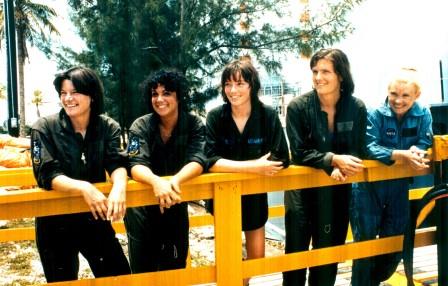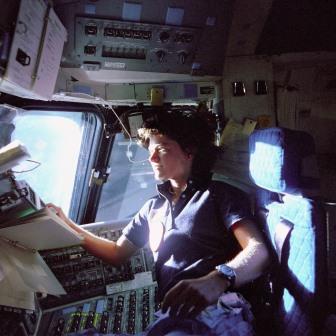
Sally Ride (1951-2012) became the first American woman in space when she flew as a mission specialist on STS-7 in 1983. She flew a second mission on the Space Shuttle Challenger on STS-41G in 1984. Ride also participated on the boards of both the Challenger and Columbia investigations. Throughout her life, she was a shining beacon of accomplishment and possibility to little girls everywhere.
Sally Ride grew up in Los Angeles and graduated from Stanford University in 1973 with bachelor’s degrees in both Physics and English. She continued her studies in Physics, and graduated from Stanford with a PhD in Astrophysics in 1978.
Seeing an advertisement in the Stanford student newspaper, she applied to be part of NASA Astronaut Group 8, the first astronaut class to select women and minorities. This was the first time that the classification of “mission specialist” was used, so NASA could begin selecting astronauts that were not necessarily military pilots. Ride was chosen to be an astronaut, along with five other women who were equally accomplished. This 1978 photo shows from left to right – Sally Ride, Judith Resnik, Anna Fisher, Kathryn Sullivan, and Rhea Seddon. The sixth woman selected, Shannon Lucid, is not pictured. These women were/are strong, but did face some difficulties in being taken seriously and achieving a measure of equality with the male astronauts.

Prior to STS-7, her first flight, Ride was absurdly asked questions at a press conference such as whether the flight would affect her reproductive organs, what kind of makeup she would be taking with her, and whether she cries when things go wrong at work. She handled these questions with grace and moved on to a successful mission that included operating the shuttle’s robotic arm to launch two communication satellites. She also was successful in her second flight STS-41G, where she was in low earth orbit for roughly 14 days, performing experiments and making earth observations.

Sally Ride was training for STS-61M when Challenger happened. She was asked to serve on the president’s commission that was appointed to investigate the tragedy that had occurred on January 28, 1986. Part of her legacy at NASA was the integrity she brought to that investigation and that she brought again when she served on the investigation of the February 1, 2003 Columbia accident. Ride was the only person who served on both commissions.
Sally Ride left NASA and returned to California in 1987, working for Stanford for a couple of years at the Center for International Security and Arms Control. Then in 1989, she became a professor of Physics at the University of California at San Diego and director of the California Space Institute.
She also co-founded Sally Ride Science (https://sallyridescience.ucsd.edu/) in 2001 and served as President and CEO. This nonprofit organization creates science programs and publications for middle school students, focusing in particular on science, technology, engineering and math (STEM) education for girls.
Sally Ride died in 2012 at the age of 61, after battling pancreatic cancer for over a year. She was quite private about her personal life. She had married fellow astronaut Steve Hawley, but they divorced in 1987. After Ride passed away, it became publicly known that she had a 27-year same-sex relationship with Tam O’Shaughnessy. This too is part of her legacy.
It would be hard to underestimate how important Sally Ride was to so many girls growing up in the 1970s and 1980s. I remember at the time, seeing the 1978 photo of the first class of women astronauts, shown above. Even now, every time I see this photo, I feel joy. The women all look so relaxed and confident.

When Sally Ride passed away, there was the traditional tree planting ceremony on-site at JSC. It was important to me to honor her memory, because of her great influence in opening the door to a new endeavor by women and for serving as such a great role model for kids interested in math and science. So I walked over to the place on-site where they have these events, and I ran into my friend Laurie, who had also come to give witness to Ride. Laurie told me that she saw Sally Ride on television when she was a kid and was so inspired, that it was absolutely one of the primary reasons she now works as an engineer at NASA/JSC.
Normally at the astronaut tree plantings, there will be a flyover of the T-38 jets from Ellington Field in the “missing man” formation, which is always very moving. However, I think there was a reason that it could not be flown that day – like maybe the president was going to be in Houston that day or something. My memory fails me.
After a few remembrances were spoken, we were each invited to put one of the red roses that were available next to the placard with Ride’s name. Even though we were hanging out in the back, I encouraged Laurie to lay a rose by the placard, and she did. It was really nice. Here is a link to a YouTube video that includes excerpts of statements made by Mike Coats, Ellen Ochoa, and Bob Crippen. It also shows footage of Sunita “Sunny” Williams who spoke about Sally Ride that day, while orbiting above us aboard the International Space Station.
Sally Ride was so influential to many girls interested in math and science, and she is a good role model for all of us adults too.
Photo Credits: NASA – public domain.















2 Comments
Leave your reply.